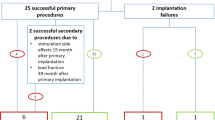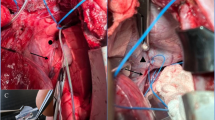Abstract
Phrenic nerve injury can lead to a disruption of the autonomic nervous system (ANS) resulting in episodes of bradycardic arrest. Implanted diaphragmatic pacing has been used to overcome phrenic nerve paralysis, but these do not change the ANS. Therefore, patients with phrenic nerve paralysis may require the implantation of a permanent cardiac pacemaker to overcome bradycardic episodes. Having two electronic devices in the same patient may lead to device–device interaction (DDI). This can result in over-sensing leading to lack of pacing of either device. We present the case of a 17-year-old pediatric male with phrenic nerve injury who required implantation of both diaphragm and cardiac pacemaker. Intra-procedural interrogation of the cardiac pacemaker demonstrated DDI in unipolar mode, but not in bipolar. Thus, we demonstrated the safe utilization of multiple implantable electronic devices in the pediatric patient without device–device interaction.



Similar content being viewed by others
References
Glenn WW, Hageman JH, Mauro A, Eisenberg L, Flanigan S, Harvard M (1964) Electrical stimulation of excitable tissue by radiofrequency transmission. Ann Surg 160(3):338–350
Weese-Mayer DE, Hunt CE, Brouillette RT, Silvestri JM (1992) Diaphragm pacing in infants and children. J Pediatr 120(1):1–8
Alshekhlee A, Onders RP, Syed TU, Elmo M, Katirji B (2008) Phrenic nerve conduction studies in spinal cord injury: applications for diaphragmatic pacing. Muscle Nerve 38(6):1546–1552
Onders R, Khansarinia S, Weiser T et al (2010) Multicenter analysis of diaphragm pacing in tetraplegics with cardiac pacemakers: positive implications for ventilator weaning in intensive care units. Surgery 148(4):893–898
Posluszny JA Jr, Onders R, Kerwin AJ et al (2014) Multicenter review of diaphragm pacing in spinal cord injury: successful not only in weaning from ventilators but also in bridging to independent respiration. J Trauma Acute Care Surg 76(2):303–310
Shaikh N, Rhaman M, Raza A, Shabana A, Malstrom M, Al-Sulaiti G (2016) Prolonged bradycardia, asystole and outcome of high spinal cord injury patients: risk factors and management. Asian J Neurosurg 11(4):427–432
Evans D, Kobrine A, Rizzoli H (1980) Cardiac arrhythmias accompanying acute compression of the spinal cord. J Neurosurg 52(1):52–59
Kolb C, Eicken A, Zrenner B, Schmitt C (2006) Cardiac pacing in a patient with diaphragm pacing for congenital central hypoventilation syndrome (Onidine’s curse). J Cardiovasc Electrophysiol 17(7):789–791
Movahed MR, Jalili M, Kiciman N (2005) Absence of Device-Device Interaction (DDI) in a patient with cardiac and diaphragmatic pacemakers for congential central hypoventilation syndrome. Pacing Clin Electrophysiol 28(11):1238–1239
Fernandes K, McLeod RL, Nikfarjam M, Weinberg L (2016) Intraoperative analysis of cross-talk inhibition between diaphragmatic and cardiac pacemakers. BMJ Case Rep bcr2015213992
Funding
All authors disclose that we do not have any funding, financial, or non-financial interests that would affect this manuscript (Dr. Snyder, Hoyt, Khan).
Author information
Authors and Affiliations
Contributions
All authors contributed to the study conception and design. Material preparation, data collection, and analysis were performed by Drs. CS, WH, and MSK. The first draft of the manuscript was written by Dr. MSK and all authors commented on previous versions of the manuscript. All authors read and approved the final manuscript.
Corresponding author
Ethics declarations
Conflict of interest
The authors have no conflict of interest.
Informed Consent
Informed consent was obtained from the study subject and no animals were used or harmed in this study.
Additional information
Publisher's Note
Springer Nature remains neutral with regard to jurisdictional claims in published maps and institutional affiliations.
Rights and permissions
About this article
Cite this article
Khan, M.S., Hoyt, W. & Snyder, C. Minimizing Device–Device Interactions Using Bipolar Pacemaker Leads in a Pediatric Patient. Pediatr Cardiol 43, 923–925 (2022). https://doi.org/10.1007/s00246-022-02816-0
Received:
Accepted:
Published:
Issue Date:
DOI: https://doi.org/10.1007/s00246-022-02816-0




